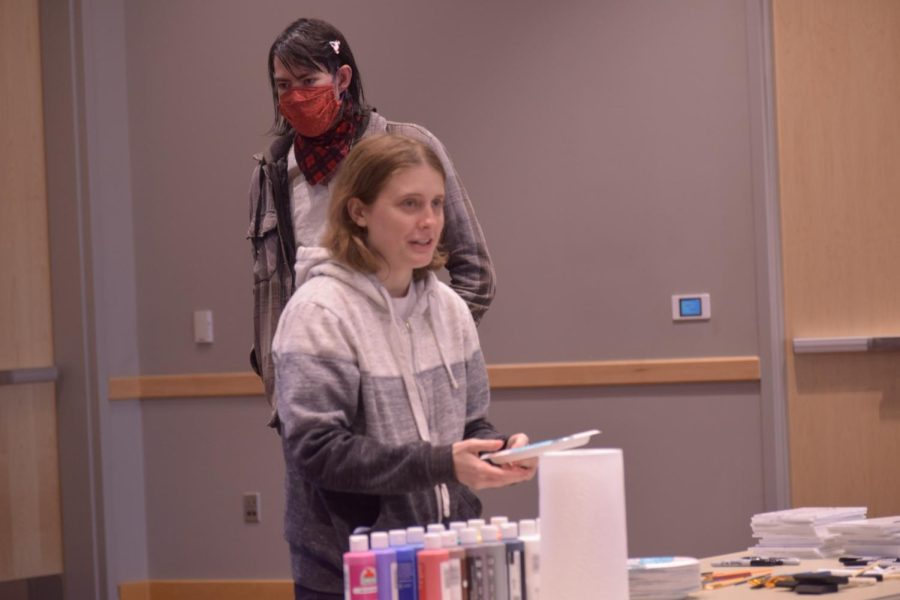Transfer students seek more guidance at UNC Asheville
Ashley Bowden, sophomore and transfer student from Indian River State College, and Dakota Estes, junior and transfer student from Asheville-Buncombe Technical Community College, participate in the transfer student mural by painting a piece of the canvas.
March 29, 2022
A college education looks different for everyone. With gap years, time off, switching majors and changing schools, there is no “right way” to complete an undergraduate degree, especially for transfer students.
“For transfer students, you’re trying to fit yourself into a community that’s already been built. You’re trying to figure out the new lay of the land and a lot of that has been during the pandemic that’s discouraged us from interacting with our communities,” said Rebecca Kelley, a senior transfer student from Asheville-Buncombe Technical Community College.
Students who transferred to UNC Asheville within the last two years embarked on an unusual start to their new college experience. Many began their classes online, met their professors and peers under the guise of a mask and depended on self-reliance to navigate their way through semesters.
Despite endless challenges thrown their way, UNCA’s transfer community is a group of dedicated students, said Sarah Smith, director of transition and parent programs.
“Our transfer students that are coming here seem very committed and on a track. They are wanting to finish, they have goals they want to accomplish, they are set on UNC Asheville,” Smith said.
Aaron Goldfarb, a sophomore from Fort Myers, Fla., began his college career at Warren Wilson College in Swannanoa. He transferred to UNCA where he’s continuing an undergraduate degree in environmental studies.
“It’s like jumping into a marathon that’s halfway done, everyone who’s in it has been there from the start, they know each other. You’re just left to go along and see if you can find your place in the race,” Goldfarb said.
Smith, along with UNCA’s Assistant Director of Admissions Lindsey Prather, a UNCA alumna who transferred from the UNC Wilmington to UNCA in 2007, are two useful points of contact for potential and current transfers.
“I help them through the application process, I let them know what the steps are going to look like, I talk to them about who is going to evaluate their transcripts. It’s very much an involved back-and-forth conversation with students,” Prather said.
Transfer students who started their first semesters at UNCA during the last two years are determined to finish their degrees despite the lack of a traditional college experience due to COVID-19. According to Prather, some admitted transfer students chose a different path.
“We did see an uptick this past year in deferrals, students who applied, had been accepted, and then, for a million different reasons, were not ready to start, so deferred their acceptance,” Prather said, “I think housing has been a big piece of the transfer decision as well. I have had quite a few students tell me that this year they were deferring because they were having trouble finding housing in Asheville.”
Transfer students typically have a year or two of college experience in their repertoire. They have a thorough understanding of college level classes and campus life, but many said they wish they received more guidance during their first semester at UNCA.
“I feel like there could be a bit more help from admissions or advisors because some people have been out of school for a long time. They need a little bit more help to find their way back to whatever path they’re on,” Goldfarb said.
Kelley said transfer resources contacted her a few times throughout her first semester, but wished for more continuous communication during her adjustment period.
“I do wish they were more communicative, especially when transfers first arrive on campus. Yes, we’ve done the college thing before, but this is an entirely new campus and resources that we aren’t familiar with. Thankfully, I’m learning about a lot of the academic resources through my major program,” she said.
Estefany Flores, a junior and transfer student from AB Tech, said she wants to be involved in campus events and organizations but felt removed from opportunities as an off-campus student.
“It would be nice to get involved just because I see the people who live on campus, how involved they are and all the fun things they attend. It seems like a good opportunity to get out there, especially as a community of college students,” Flores said.
With resources such as the UNCA Now app, campus events and student organizations provide ways for student engagement at UNCA, but Prather said transfer resources could do a better job of engaging the transfer community in these activities.
“In full transparency, across student affairs and across higher education in general, there are lots of vacancies within departments. With COVID and limited resources, we’ve had to re-shift our priorities at different times.” Smith said “We tried some outreach programs last year and didn’t get as great of a turnout because COVID.”
Prather and Smith said they appreciate the numerous ways transfer students contribute and aid the campus and community in becoming a better environment for its students.
“One of the beauties of UNC Asheville is that we value student input and we listen to it. So, I think transfer students have a greater context of perspective because they’ve attended another school. They value and appreciate all the awesome things we do, but they also have more ideas on how we can be better,” Prather said.


















